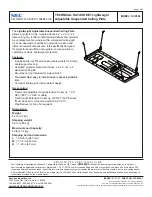
Power supply
:
12-24V AC/DC
Working Temp.
:
-20°C / +55°C
Current consumption
:
max. 25mA
Cover IP
:
54
Range
:
1 - 15m
Dimensions:
35x30x110mm
In case of problems with identifying the AC power cable, you can use the following
procedure, in order to connect two pairs of photocells located in one area of the optical range
:
4
make sure the jumper labeled '
ZW
' in transmitters and receivers of both pairs of photocells are cut
(open),
4
Connect the power supply
12-24V AC (alternating)
to the transmitter and the receiver of the first pair of
photocells.
POWER
diode should light on the transmitter and receiver, as well as the
RX
diode on the
receiver. If the
RX
diode is off, swap wire only on the transmitter side or only on the receiver side. If the
RX diode still not light, it means that the receiver can not "see" the ray of the transmitter - adjust the
position of the transmitter or receiver and, if necessary, repeat this step.
4
supply power to the receiver of the second pair of photocells. The result should be to light only the
POWER
diode on the receiver.
RX
diode should remain off (meaning no reaction of the receiver of the
second pair of photocells on the ray from the transmitter of the first pair of photocells). If the
RX
diode is
light, swap the receiver supply wire.
4
Supply power to the transmitter of the second pair of photocells. The POWER diode on the transmitter
should light, the RX diode on the receiver of second pair of photocells should also light up. If the RX diode
is off, swap the transmitter supply wire.
4
Connect the photocell receiver signal terminals (usually NC and C) to the proper input of the control
unit. Pay particular attention to the type of control (NC or NO) required in the control panel. The standard
solution for gate automation is the work in optical sensors in the NC.
5. Receiving tests.
After photocell connection is done, it is recommended to check receiver (RX) reaction on Irfarared
signal breaks. Gate automation systems must be tested conformity to EN 12445 standard.
Photocell test:
4
Supply power to receiver only and check if RX diode out.
4
Supply power to transmitter and check if RX diode light.
4
Displace roller of 5 cm diameter and 30 cm length, to break perpendiculary optical axis between
receiver and transmitter. First in the vacinity of transmitter TX, next in the vacinity of receiver RX,
next in the middle of distance between them. In all cases photocell should switch from standby to
alarm mode, which is signalized by RX diode wane.
6. Warranty.
DTM System checks all the devices before shipping. The warranty time is 24 months from the
selling date. This time is counted according to the warranty label. The manufacturer will fix all the
problems which come because of his fault. Non functionaing device should be delivered back to the
distributor with short problem description. The cost of mount/dismount is covered by user. The warranty
do not cover: batteries in the remotes, faults caused by improper usage, user self reairs and adaptations,
lightning strikes, over voltages or short circuits in the mains supply. Appropriate legal acts regulates
details of the warranty.
The intention of the WEEE Directive (Directive 2002/96/EC on waste electrical and electronic
equipment) is to reduce the amount of hazardous substances in waste.
The underlying purpose is to promote the avoidance, recovery and risk-free disposal of waste.
DTM System spółka z ograniczoną odpowiedzialnością spółka komandytowa
ul. Brzeska 7, 85-145 Bydgoszcz
tel./fax. (52) 340-15-83, 340-15-84
www.dtm.pl, [email protected]






















